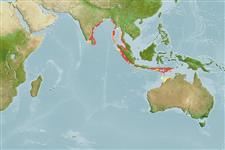>
Kurtiformes (Nurseryfishes, cardinalfishes.) >
Apogonidae (Cardinalfishes) > Apogoninae
Etymology: Taeniamia: Name from feminine Latin noun 'taenia' meaning ribbon or band; and feminine Greek noun 'Amia' meaning a fish, often used with cardinalfishes genera. Here as Taeniamia referring to the vertical wide bars and near vertical to curved narrow bars as lines on most of the species in this genus; ataenia: ataenia in reference to the absence of the broad black bar on the body as seen on A. zosterophora.
More on authors: Randall & Satapoomin.
Environment: milieu / climate zone / depth range / distribution range
Ecologia
marinhas associadas(os) a recifes; intervalo de profundidade 0 - 7 m (Ref. 41635). Tropical
Eastern Indian Ocean: Andaman Sea and Mentawai Islands off southwestern Sumatra.
Tamanho / Peso / Idade
Maturity: Lm ? range ? - ? cm
Max length : 4.8 cm SL macho/indeterminado; (Ref. 54391)
Descrição breve
Chaves de identificação | Morfologia | Morfometria
Espinhos dorsais (total) : 7; Raios dorsais moles (total) : 9; Espinhos anais: 2; Raios anais moles: 14 - 16. Diagnosis: Dorsal rays VII,9; anal rays 11,14-16 (usually 15); pectoral rays 13-14 (usually 14). Lateral-line scales 25 + 3. Median predorsal scales 6-7. Gill rakers 5-6 + 15-16. Body depth 2.4-3.3 in SL, and body width 2.1-2.8 in the depth. Eye diameter 2.85-3.3 in head length> First dorsal spine 1.4-2.4 in second spine; second dorsal spine 2.5-3.2, and third dorsal spine 2.4-3.3, in head length; spine of second dorsal fin 2.2-2.7, and second anal spine 2.3-3.0, in head length; pelvic-fin length 4.5-5.1, and caudal-peduncle length 4.45.7 in SL. Distance from insertion of pelvic spine to anal-fin origin 4.2-5.9 in SL. Preopercular ridge smooth with a small flat spine at angle; the preopercular edge fully serrate; posterior edge of maxilla indented. Scaly sheath along anal-fin base moderately developed (Ref. 54391).
Specimens collected from aggregations that took refuge in a colony of branching coral (Ref. 41635). Minimum depth taken from Ref. 57178.
Life cycle and mating behavior
Maturidade | Reprodução | Desova | Ovos | Fecundidade | Larvas
Mouthbrooders (Ref. 240). Distinct pairing during courtship and spawning (Ref. 205).
Gon, O. and J.E. Randall, 2003. Revision of the Indo-Pacific cardinalfish genus Archamia (Perciformes: Apogonidae), with description of a new species. Indo-Pac. Fish. (35):49 p. (Ref. 54391)
Categoria na Lista Vermelha da IUCN (Ref. 130435: Version 2024-1)
Ameaça para o homem
Harmless
Utilização humana
Ferramentas
Relatórios especiais
Descarregue XML
Fontes da internet
Estimates based on models
Preferred temperature (Ref.
123201): 28.3 - 29.4, mean 28.8 °C (based on 243 cells).
Phylogenetic diversity index (Ref.
82804): PD
50 = 0.5001 [Uniqueness, from 0.5 = low to 2.0 = high].
Bayesian length-weight: a=0.01445 (0.00680 - 0.03071), b=3.07 (2.89 - 3.25), in cm total length, based on LWR estimates for this (Sub)family-body shape (Ref.
93245).
Nível Trófico (Ref.
69278): 3.3 ±0.5 se; based on size and trophs of closest relatives
Resiliência (Ref.
120179): Elevada, tempo mínimo de duplicação da população menor que 15 meses (Preliminary K or Fecundity.).
Fishing Vulnerability (Ref.
59153): Low vulnerability (10 of 100).
